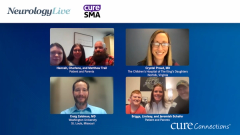
Evaluating SMA in Children and Adolescents Through Telehealth Exams
An overview of the signs and symptoms that physicians look for in telehealth exams when SMA is suspected.
Episodes in this series

Crystal Proud, MD: Dr Zaidman, you mentioned some important components of things you look for and what camera view is most helpful. I echo your thoughts on that. Having a broader view of the person we’re examining is going to be helpful, especially if we’re looking at a relatively new patient. Even if it’s a baby, having a broad view of an individual on telehealth is going to help you more than a view of the torso and head. If you’re looking for signs and symptoms of spinal muscular atrophy [SMA] in particular, what things might you attend to when you’re doing that telehealth exam?
Craig Zaidman, MD: To start, I like to make good eye contact. I want to see the patient up close, so I can get to know them a little and make a connection. I’m also always looking at how somebody’s face moves. I want to hear their speech very clearly. I want to see how they’re able to swallow their saliva, how their tongue works, and how their eyes move. That’s the easiest part in a way, but you have to be close enough to the camera to see those things.
From then, I like to see the whole body if I can, as you mentioned. If I have to see a patient in a seated position, I want them to hold their hands out so I can see their hands. I prefer them to have a short-sleeve shirt on. I can usually tell if a muscle is atrophic or thin from looking at the hands pretty easily, so I’ll have patients hold their hands out for me so I can see them. I like to see their legs for the same reason. In spinal muscular atrophy, sometimes you can see that the arms or legs are too skinny. You often notice that in the legs. Seeing the thighs can be very helpful. Thighs are often thin and skinny. Sometimes I’ll ask the parents to squeeze the thighs and see if it feels the same in the patient as it does in them. That would usually be a diagnostic maneuver. As we already mentioned, these are usually follow-up appointments of an established diagnosis, so that’s not as critical.
For my patients who are seated, I like them to raise their arms over their head if they’re able to. I like to see exactly how they do that. There’s a difference between going straight up over your head [and putting them out in front of your head]. Those aren’t the same things. You want to be out and straight up if you’re able to do that. It’s the same with touching your nose. If you can do it this way, that’s different from only doing it this way. The first examples of each of those require more strength, as you know, Dr Proud. That’s how I get through it.
The most helpful thing for me is to see the patient’s full body sitting on the ground or in a chair. I like to see them stand up from a chair or sit up from lying down. That’s very helpful to see how a patient attempts to go from lying to sitting or sitting to standing. If a patient is able to walk, I always have them walk. I have them stand on 1 foot, stand on their toes, stand on their heels, and jump. With some of my patients who are able to jump, I have them measure how far they can jump by doing what we call a standing broad jump. Families can monitor that at home. If I can, I like to see them run and go up the stairs, as you said.
In patients with SMA or weakness of any kind, it would be difficult to sit up or stand up. It would be difficult to stand up out of a chair. Patients will have to push off their knees in order to get up or push off a desk in order to stand up. When you see a patient go up and down the stairs or you see a patient try to run, they will often be what we call upright. Their chest, belly, and head all stay perfectly upright even though they’re running, whereas a patient with full strength will typically lean forward and run while leaning slightly forward. That upright run is a telltale sign that a patient is weak.
I hope that covers it, Dr Proud. The take-home point for the physicians who are watching this is that you can diagnose weakness on telehealth and you can characterize whether weakness is in the shoulder and hip girdle or in the hands and feet, but you can’t make a diagnosis of SMA. You can only say the patient is weak in this pattern. But without checking the reflexes, it’s hard to differentiate between SMA and other more common things, like myopathies and other neuropathies that are even more common, like Charcot-Marie-Tooth disorder. Ultimately, if you’re in the diagnostic phase, you have to see somebody in person.
Transcript edited for clarity.
Newsletter
Keep your finger on the pulse of neurology—subscribe to NeurologyLive for expert interviews, new data, and breakthrough treatment updates.



























